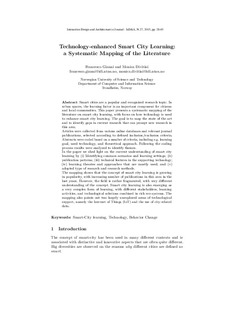| dc.contributor.author | Gianni, Francesco Valerio | |
| dc.contributor.author | Divitini, Monica | |
| dc.date.accessioned | 2019-07-05T11:55:38Z | |
| dc.date.available | 2019-07-05T11:55:38Z | |
| dc.date.created | 2016-03-29T12:27:09Z | |
| dc.date.issued | 2016 | |
| dc.identifier.citation | ID&A Interaction design & architecture(s). 2016, 27 28-43. | nb_NO |
| dc.identifier.issn | 1826-9745 | |
| dc.identifier.uri | http://hdl.handle.net/11250/2603642 | |
| dc.description.abstract | Smart cities are a popular and recognized research topic. In urban spaces, the learning factor is an important component for citizens and local communities. This paper presents a systematic mapping of the literature on smart city learning, with focus on how technology is used to enhance smart city learning. The goal is to map the state of the art and to identify gaps in current research that can prompt new research in this area. Articles were collected from various online databases and relevant journal publications, selected according to defined inclusion/exclusion criteria. Abstracts were coded based on a number of criteria, including e.g. learning goal, used technology, and theoretical approach. Following the coding process results were analyzed to identify themes. In the paper we shed light on the current understanding of smart city learning by (i) Identifying common scenarios and learning settings; (ii) publication patterns; (iii) technical features in the supporting technology; (iv) learning theories and approaches that are mostly used; and (v) adopted type of research and research methods. The mapping shows that the concept of smart city learning is growing in popularity, with increasing number of publications in this area in the last years. However, the field is rather fragmented, with very different understanding of the concept. Smart city learning is also emerging as a very complex form of learning, with different stakeholders, learning activities, and technological solutions combined in rich eco-systems. The mapping also points out two largely unexplored areas of technological support, namely the Internet of Things (IoT) and the use of city-related data. | nb_NO |
| dc.language.iso | eng | nb_NO |
| dc.publisher | Scuola IaD | nb_NO |
| dc.rights | Attribution-NonCommercial-NoDerivatives 4.0 Internasjonal | * |
| dc.rights.uri | http://creativecommons.org/licenses/by-nc-nd/4.0/deed.no | * |
| dc.subject | Smart-City learning, Technology, Behavior Change | nb_NO |
| dc.title | Technology-enhanced Smart City Learning: a Systematic Mapping of the Literature | nb_NO |
| dc.type | Journal article | nb_NO |
| dc.type | Peer reviewed | nb_NO |
| dc.description.version | publishedVersion | nb_NO |
| dc.source.pagenumber | 28-43 | nb_NO |
| dc.source.volume | 27 | nb_NO |
| dc.source.journal | ID&A Interaction design & architecture(s) | nb_NO |
| dc.identifier.cristin | 1347243 | |
| dc.description.localcode | CC BY-NC-ND | nb_NO |
| cristin.unitcode | 194,63,10,0 | |
| cristin.unitname | Institutt for datateknologi og informatikk | |
| cristin.ispublished | true | |
| cristin.fulltext | original | |
| cristin.qualitycode | 1 | |

